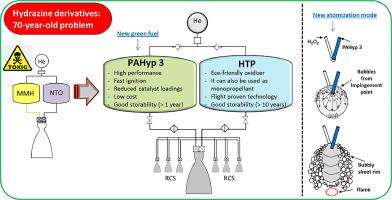Ignition envelope and bubbly spray combustion of a cost-effective self-igniting fuel with rocket-grade hydrogen peroxide
IF 5.8
2区 工程技术
Q2 ENERGY & FUELS
引用次数: 0
Abstract
Since the beginning of this century, the space industry has been searching for stable non-toxic propellants to replace hydrazine-based fuels. In this paper, we introduce a novel eco-friendly self-igniting fuel, denoted PAHyp 3, which comprises a blend of N,N,N′,N′-tetramethylethylenediamine (TMEDA) and N-methylethanolamine (MMEA) catalyzed with a copper-based catalyst. This promising formulation is coupled with hydrogen peroxide as the oxidizer. To map near-optimal formulations in terms of performance and chemical stability, we varied the proportions of MMEA and TMEDA, each catalyzed with copper nitrate trihydrate concentrations ranging from 0.25% to 3% by weight. Drop tests revealed that a 50:50 mixture of TMEDA and MMEA, catalyzed with 2 wt% copper nitrate trihydrate, exhibited a rapid ignition delay time (IDT) of approximately 14 ms when paired with 94% hydrogen peroxide. This composition was subsequently chosen for evaluation using an impinging jet apparatus capable of capturing simultaneous visible and shadowgraph high-speed imaging, facilitating the detailed study of the ignition process. Screenshots from impinging jet firing tests unveiled that the majority of ignition events, utilizing 94% hydrogen peroxide, occurred downstream less than 20 ms after impingement. Subsequently, foam-like structures engulfed the vaporized and combusted liquid sheet, emitting stable orange/green flames. These promising outcomes indicate that PAHyp 3 presents novel prospects in aerospace propulsion, with the potential to replace hazardous and toxic hydrazine-based propellants. Moreover, a model was proposed to explain how bubble nucleation and growth from hydrogen peroxide decomposition can enhance atomization, leading to a new atomization mode we have termed “catalytic decomposition-assisted atomization”.

使用火箭级过氧化氢的经济高效自燃燃料的点火包络和气泡喷雾燃烧
自本世纪初以来,航天工业一直在寻找稳定无毒的推进剂来替代肼基燃料。本文介绍了一种新型环保自燃燃料 PAHyp 3,它由 N,N,N′,N′-四甲基乙二胺(TMEDA)和 N-甲基乙醇胺(MMEA)在铜基催化剂催化下混合而成。这种前景广阔的配方与作为氧化剂的过氧化氢配合使用。为了绘制出在性能和化学稳定性方面接近最佳的配方,我们改变了 MMEA 和 TMEDA 的比例,每种配方在三水硝酸铜催化下的浓度从 0.25% 到 3% (按重量计)不等。跌落测试表明,在 2 wt% 的三水硝酸铜催化下,50:50 的 TMEDA 和 MMEA 混合物与 94% 的过氧化氢配对时,可显示出约 14 毫秒的快速点火延迟时间 (IDT)。随后,我们选择了这种成分,使用可同时捕捉可见光和阴影图高速成像的撞击喷射装置进行评估,从而促进了对点火过程的详细研究。冲击射流点火试验的截图显示,使用 94% 过氧化氢的大多数点火事件都发生在冲击后不到 20 毫秒的下游。随后,泡沫状结构吞噬了汽化和燃烧的液态薄片,发出稳定的橙色/绿色火焰。这些令人鼓舞的结果表明,PAHyp 3 在航空航天推进方面具有新的前景,有可能取代危险和有毒的肼基推进剂。此外,我们还提出了一个模型,用于解释过氧化氢分解产生的气泡成核和增长如何增强雾化效果,从而产生了一种新的雾化模式,我们称之为 "催化分解辅助雾化"。
本文章由计算机程序翻译,如有差异,请以英文原文为准。
求助全文
约1分钟内获得全文
求助全文
来源期刊

Combustion and Flame
工程技术-工程:化工
CiteScore
9.50
自引率
20.50%
发文量
631
审稿时长
3.8 months
期刊介绍:
The mission of the journal is to publish high quality work from experimental, theoretical, and computational investigations on the fundamentals of combustion phenomena and closely allied matters. While submissions in all pertinent areas are welcomed, past and recent focus of the journal has been on:
Development and validation of reaction kinetics, reduction of reaction mechanisms and modeling of combustion systems, including:
Conventional, alternative and surrogate fuels;
Pollutants;
Particulate and aerosol formation and abatement;
Heterogeneous processes.
Experimental, theoretical, and computational studies of laminar and turbulent combustion phenomena, including:
Premixed and non-premixed flames;
Ignition and extinction phenomena;
Flame propagation;
Flame structure;
Instabilities and swirl;
Flame spread;
Multi-phase reactants.
Advances in diagnostic and computational methods in combustion, including:
Measurement and simulation of scalar and vector properties;
Novel techniques;
State-of-the art applications.
Fundamental investigations of combustion technologies and systems, including:
Internal combustion engines;
Gas turbines;
Small- and large-scale stationary combustion and power generation;
Catalytic combustion;
Combustion synthesis;
Combustion under extreme conditions;
New concepts.
 求助内容:
求助内容: 应助结果提醒方式:
应助结果提醒方式:


